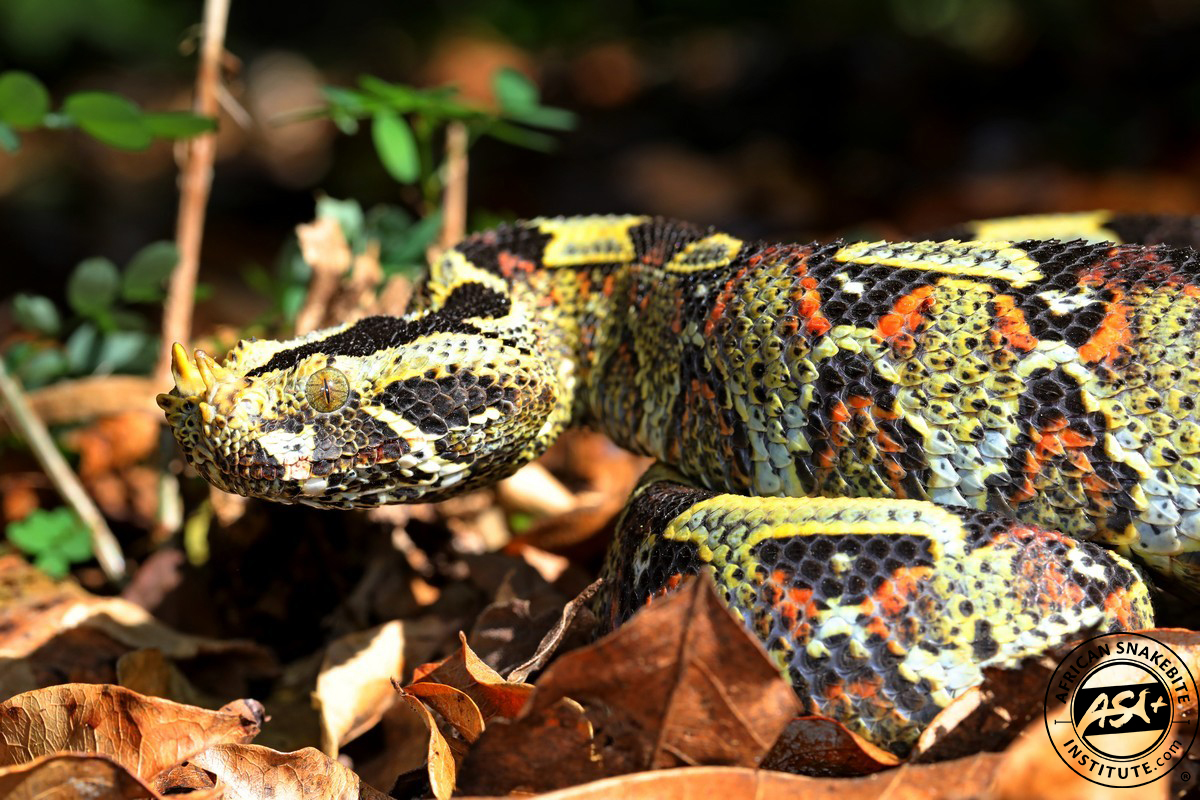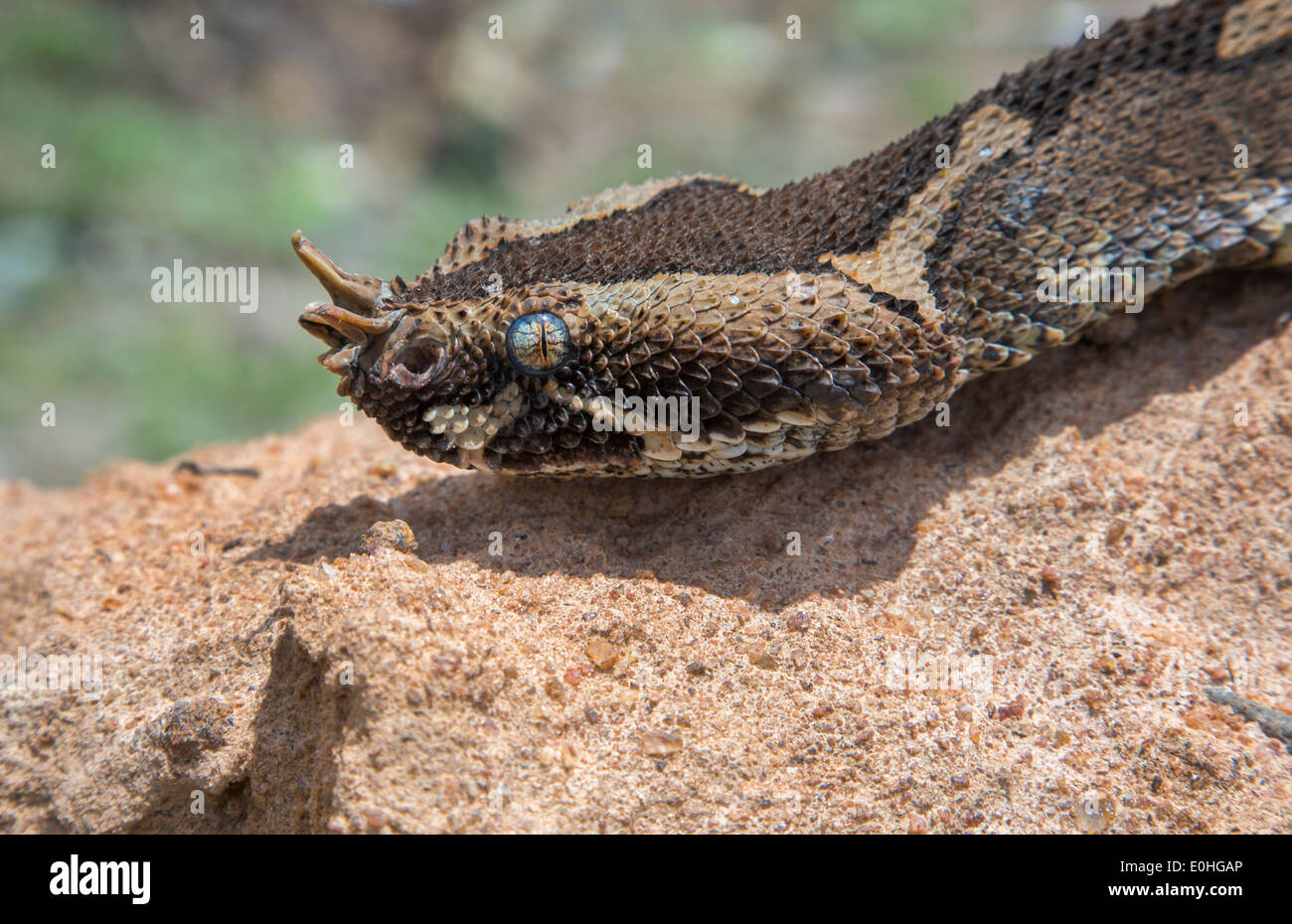

Mature females are usually larger than males.

A large, healthy specimen can weigh 25 pounds. The longest fangs measured were 2.3 inches. The fangs are the longest, relatively, of any venomous snake. They have the typical viper-triangle head (which, in large snakes may be 6 inches across), with a blunted muzzle and wide-set jaw bones, accommodating the large venom glands and making the back of the head obviously wider than the neck. They are the heaviest of snakes for their length. Gaboons are big snakes, made bigger by their body bulk. rhinoceros, with larger horns and one triangle under each eye. gabonica, with small horns and two triangles under the eyes, and the Western, B. There are 2 subspecies of Gaboon, the Eastern, B. In the southernmost populations, which are disjunct from the main range of the species, the climate is subtropical and seasonal differences in activity are observed, but radiotelemetry studies conducted in tropical areas of Cameroon and Nigeria show no seasonal changes in behavior.The Gaboon is sometimes called Gabon Viper because the “type” locality (the place where it was found) is in the country of Gabon, western Africa. Sometimes called “Rhinoceros Viper” (because of a pointed, horn-like scale on the tip of the rostrum), this species is not to be confused with its close “cousin” Bitis nasicornis, the Rhinoceros Viper, which has 2 to 4 large, thorn-like “horns” on its rostrum. Much recent research on Gaboon Vipers has taken place in South Africa, where they are known as Gaboon Adders. Little is known about their reproductive behavior, but males combat one another over females, which must be an impressive sight. Like most vipers, female Gaboon Vipers give birth to a litter of live young once every two to three years, usually between 20 and 40. Unfortunately, this is one of the only plates not in color Gaboon Viper plate from Duméril, Bibron, & Duméril's Erpétologie G é n é rale Like most snakes, particularly slow-moving ones with good camouflage, Gaboon Vipers usually sit still and remain unnoticed whenever a human comes nearby (so in other words, pretty much the exact same thing they were already doing). They are undoubtedly dangerous snakes, but envenomations are few compared to such infamous species as the Russell's Viper. Being stepped on and squashed by these large herbivores might be the primary cause of mortality for adult vipers, which are not vulnerable to many natural predators.Īlthough Gaboon Vipers produce prodigious amounts of venom (nearly 10 mL), the toxicity is rather low compared to other venomous snakes, and there are only a few detailed clinical reports of bites. At no point during either encounter did the snake hiss or show aggression in any manner", writes Jonathan Warner in his dissertation, which also contains evidence that hippos, elephants, and leopards may walk right by Gaboon Vipers without noticing them. gabonica during the course of radiotracking, only becoming aware of this after feeling squirming movement beneath my foot.

"On two occasions, I accidentally stepped directly on B. In spite of its impressive size, or perhaps because of it, Gaboon Vipers are, like many of their kin, docile and retiring. As with most snakes, life as a Gaboon Viper is probably pretty dull. 1 The preferred habitat of Gaboon Vipers is a mosaic of forest, thicket, and grassland, although they will sometimes enter sugarcane fields and rural gardens. Every so often, a viper, particularly a male during the breeding season of March through May, will embark on a long-distance movement of one quarter to two thirds of a mile, sometimes in a single day. They spend between three-quarters and 95% of their time just sitting quietly, sometimes for up to three months at a time. A very low metabolism permits them to wait in one spot for weeks, until the perfect opportunity presents itself. Long folding fangs and deadly venom allow them to kill their prey while keeping a safe distance from it. Like many vipers, Gaboon Vipers are ambush predators, a lifestyle to which they are supremely adapted.


 0 kommentar(er)
0 kommentar(er)
